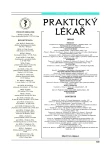Risk factors and prevalence of bad posture in school-age children
Authors:
J. Kratěnová 1; K. Žejglicová 1; M. Malý 1; V. Filipová 2
Authors‘ workplace:
Státní zdravotní ústav, Praha, Centrum hygieny životního prostředí
vedoucí MUDr. R. Kubínová
1; Zdravotní ústav Středočeského kraje, Praha
ředitel MUDr. M. Svoboda
2
Published in:
Prakt. Lék. 2005; 85(11): 629-634
Category:
Of different specialties
Overview
In 2003, a cross-sectional prevalence study was used to detect the incidence of defective body posture in a representative sample of 3250 children aged 7, 11 and 15 years in 10 towns of the Czech Republic. Differences in the incidence of defective body posture were found particularly between ages 7 and 11 (33.0 % and 40.8 %; p<0.001). Between ages 11 and 15 these differences were insignificant (40.8 % and 40.6 %; p=0.944).
In total, paediatricians in 38.3 % of examined children, particularly boys, diagnosed defective body posture. The most frequent defects comprised protruding shoulder blades (50 % of all children), increased lumbar lordosis (32 %) and rounded back (31 %). Incidence of defective body posture was significantly higher in children suffering from pathological frontal curvature of the spine (p<0.001), rounded back (p<0.001) and increased lumbar lordosis (p<0.001).
Children with defective body posture reported more frequent pain (at least 1x a month) in the head, upper vertebrae, and lower back.
Scoliosis was diagnosed in 5.8 % of examined children. Prevalence increased significantly with age and the highest incidence and number of new cases was detected amongst the 15 year-olds.
The group included 14 % of children with high BMI (exceeding the 90th percentile); these children had a lower incidence of defective body posture (p= 0.045) and scoliosis (p=0.004).
Zero sports activity was reported by 18.9 % of children, who had an increased likelihood of defective body posture in comparison to children participating in sports at least 1x weekly (p<0.001). On average, the children spent 4 hours per week engaged in sports and 14 hours per week watching TV, video, and playing computer games.
Key words:
body posture – scoliosis – pain – BMI – children.
Labels
General practitioner for children and adolescents General practitioner for adultsArticle was published in
General Practitioner

2005 Issue 11
Most read in this issue
- Quality of life – defining the concept and its significance for medicine and health care
- Essential hypertension – a review
- Treatment and clinical manifesta- tions of primary intraocular lymphoma
- Risk factors and prevalence of bad posture in school-age children
